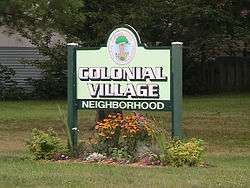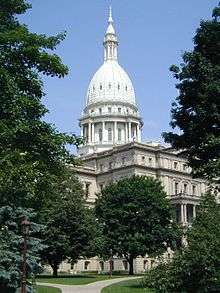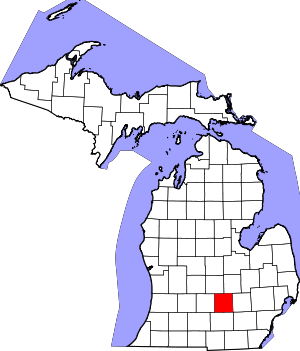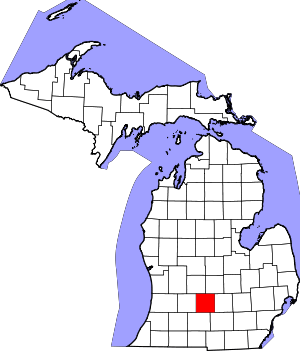Lansing, Michigan
Lansing /ˈlænsɪŋ/ is the capital of the U.S. state of Michigan. It is mostly in Ingham County, although portions of the city extend west into Eaton County and north into Clinton County. The 2010 Census placed the city's population at 114,297,[7] making it the fifth largest city in Michigan. The population of its Metropolitan Statistical Area (MSA) was 464,036, while the even larger Combined Statistical Area (CSA) population, which includes Shiawassee County, was 534,684. It was named the new state capital of Michigan in 1847, ten years after Michigan became a state.
Lansing, Michigan | |
|---|---|
State capital and city | |
| City of Lansing | |
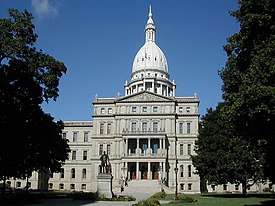 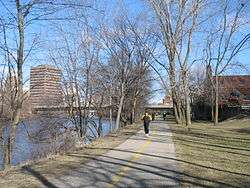 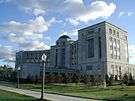 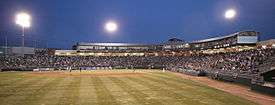 Clockwise from top left: Downtown Lansing skyline, Michigan Supreme Court Hall of Justice, Cooley Law School Stadium, Michigan State Capitol | |
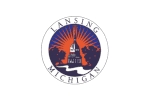 Flag  Seal | |
| Nickname(s): Capital City, L-Town, "The Heart of Michigan" | |
 Location in Ingham County, Michigan[lower-alpha 2] | |
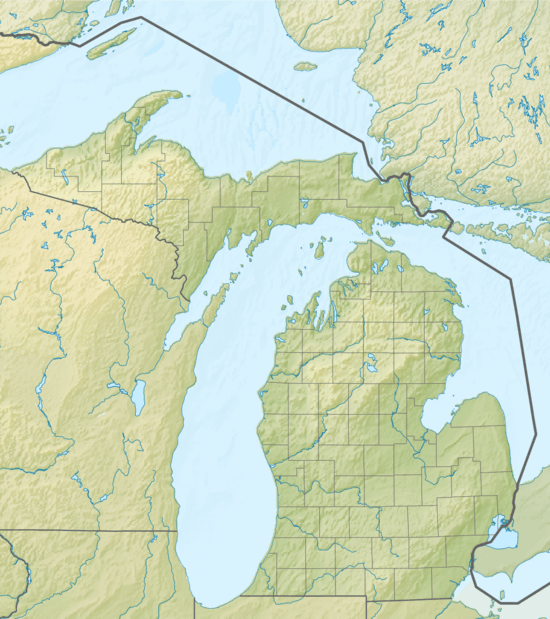 Lansing, Michigan Location in Michigan, United States & North America  Lansing, Michigan Lansing, Michigan (the United States) 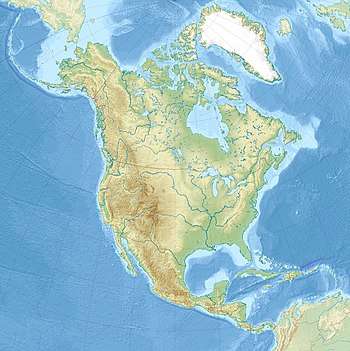 Lansing, Michigan Lansing, Michigan (North America) | |
| Coordinates: 42°44′1″N 84°32′48″W | |
| Country | |
| State | |
| Counties | Ingham, Clinton, Eaton |
| Settled | 1835 |
| Incorporation | 1859 |
| Named for | Lansing, New York |
| Government | |
| • Type | Strong Mayor-Council |
| • Mayor | Andy Schor (D) |
| Area | |
| • City | 39.83 sq mi (103.16 km2) |
| • Land | 39.19 sq mi (101.50 km2) |
| • Water | 0.64 sq mi (1.66 km2) |
| • Urban | 158.2 sq mi (354.4 km2) |
| • Metro | 1,714.6 sq mi (4,440.8 km2) |
| Elevation | 860 ft (262 m) |
| Population | |
| • City | 114,297 |
| • Estimate (2019)[3] | 118,210 |
| • Density | 3,016.48/sq mi (1,164.67/km2) |
| • Urban | 313,532 |
| • Metro | 464,036 |
| • CSA | 534,684 |
| Demonym(s) | Lansingite |
| Time zone | UTC−5 (EST) |
| • Summer (DST) | UTC−4 (EDT) |
| ZIP code | 48901-48980[4] |
| Area code(s) | 517 |
| FIPS code | 26-46000[5] |
| GNIS feature ID | 1625035[6] |
| Website | www |
The Lansing metropolitan area, colloquially referred to as "Mid-Michigan", is an important center for educational, cultural, governmental, commercial, and industrial functions. Neighboring East Lansing is home to Michigan State University, a public research university with an enrollment of more than 50,000.[8] The area features two medical schools, one veterinary school, two nursing schools, and two law schools. It is the site of the Michigan State Capitol, the state Supreme Court, the Court of Appeals, a federal court, the Library of Michigan and Historical Center, and headquarters of four national insurance companies.
Lansing is the only U.S. state capital (among the 47 located in counties) that is not also a county seat. The seat of government of Ingham County is Mason,[9] but the county maintains some offices in Lansing.[10]
History
The first recorded person of European descent to travel through the area that is now Lansing was British fur trader Hugh Heward and his French-Canadian team on April 24, 1790 while canoeing the Grand River.[11][12] The land that was to become Lansing was surveyed as "Township 4 North Range 2 West" in February 1827 in what was then dense forest. It was the last of the county's townships to be surveyed, and the land was not offered for sale until October 1830.[13] There would be no roads to this area for decades to come.
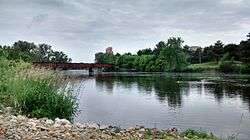
In the winter of 1835 and early 1836, two brothers from New York plotted the area now known as REO Town just south of downtown Lansing and named it "Biddle City". This land lay in a floodplain and was underwater during the majority of the year. Nevertheless, the brothers went back to Lansing, New York, to sell plots for the town that did not exist. They told the New Yorkers this new "city" had an area of 65 blocks, a church and a public and academic square. 16 men bought plots in the nonexistent city, and upon reaching the area later that year found they had been scammed. Many in the group, too disappointed to stay, ended up settling around what is now metropolitan Lansing. Those who stayed quickly renamed the area "Lansing Township" in honor of their home village in New York.[14]
The settlement of fewer than 20 people would remain dormant until the winter of 1847 when the state constitution required the capital be moved from Detroit to a more central and safer location in the state's interior; many were concerned about Detroit's proximity to British-controlled Canada, which had captured Detroit in the War of 1812. The United States had recaptured the city in 1813, but these events led to the dire need to have the center of government relocate from hostile British territory. There was also concern with Detroit's strong influence over Michigan politics, being the state's largest city as well as the capital city.[14]
During the multi-day session to determine a new location for the state capital, many cities, including Ann Arbor, Marshall, and Jackson, lobbied hard to win this designation.[15] Unable to publicly reach a consensus because of constant political wrangling, the Michigan House of Representatives privately chose the Township of Lansing out of frustration. When announced, many present openly laughed that such an insignificant settlement was now Michigan's capital. Two months later, Governor William L. Greenly signed into law the act of the legislature making Lansing Township the state capital.[14]

With the announcement that Lansing Township had been made the capital, the small village quickly transformed into the seat of state government. The legislature gave the settlement the temporary name of the "Town of Michigan". In April 1848, the legislature then gave the settlement the name of "Lansing".[16] Within months after it became the capital city, individual settlements began to develop along three key points along the Grand River in the township:[14]
- "Lower Village/Town", where present-day Old Town stands, was the oldest of the three villages. It was home to the first house built in Lansing in 1843 by pioneer James Seymour and his family. Lower Town began to develop in 1847 with the completion of the Franklin Avenue (now Grand River Avenue) covered bridge over the Grand River.[17]
- "Upper Village/Town", where present-day REO Town stands at the confluence of the Grand River and the Red Cedar River. It began to take off in 1847 when the Main Street Bridge was constructed over the Grand River. This village's focal point was the Benton House, a 4-story hotel which opened in 1848. It was the first brick building in Lansing and was later razed in 1900.[17]
- "Middle Village/Town", where downtown Lansing now stands, was the last of the three villages to develop in 1848 with the completion of the Michigan Avenue bridge across the Grand River and the completion of the temporary capitol building which sat where Cooley Law School stands today on Capitol Avenue between Allegan and Washtenaw Streets, and finally the relocation of the post office to the village in 1851. This area would grow to become larger than the other two villages up and down river. For a brief time the combined villages were referred to as "Michigan" but was officially named Lansing in 1848.[17]
In 1859, the settlement having grown to nearly 3,000 and encompassing about seven square miles (18 km2) in area was incorporated as a city. The boundaries of the original city were Douglas Avenue to the north, Wood and Regent streets to the east, Mount Hope Avenue to the south, and Jenison Avenue to the west. These boundaries would remain until 1916. Lansing began to grow steadily over the next two decades with the completion of the railroads through the city, a plank road, and the completion of the current capitol building in 1878.
Most of what is known as Lansing today is the result of the city becoming an industrial powerhouse which began with the founding of Olds Motor Vehicle Company in August 1897. The company went through many changes, including a buyout, between its founding to 1905 when founder Ransom E. Olds started his new REO Motor Car Company, which would last in Lansing for another 70 years. Olds would be joined by the less successful Clarkmobile around 1903.[18] Over the next decades, the city would be transformed into a major American industrial center for the manufacturing of automobiles and parts, among other industries. The city also continued to grow in area. By 1956, the city had grown to 15 square miles (39 km2), and doubled in size over the next decade to its current size of roughly 33 square miles (85 km2).[19]
Today, the city's economy is diversified among government service, healthcare, manufacturing, insurance, banking, and education.
Notable events
The Kerns Hotel fire on 11 December 1934 was the deadliest in the city's history. Perhaps thirty-four people died in the fire, although the hotel register was also destroyed making an exact count impossible.
Elephant incident
On September 26, 1963, a 12-year-old, 3,000-pound female dancing elephant named Rajje (alternately reported as Raji and Little Rajjee, among other variations) rebelled against her trainer during a performance in a shopping-center circus near what was then Logan Street and Holmes Road in Lansing, and escaped into the streets, aggravated by the frenzied pursuit of nearly 4,000 local residents. The incident ended with the shooting of the elephant by Lansing police.[20][21] Provoked by the growing crowd, Rajje's rampage took her through the men's wear, sporting goods and gift departments of a local Arlan's discount store before leading police on a two-mile chase in which she knocked down and injured a 67-year-old man, tried to move a car, and caused thousands of dollars in damage before being killed.
Life Magazine quoted Rajje's trainer, William Pratt, as shouting at the scene, "Damn these people [...] They wouldn't leave her alone."[20]
The incident was widely reported, including a photospread in Life.[20] While the Lansing State Journal coverage stressed the danger of the incident,[22] the Detroit Free Press noted that witnesses cried out "Murderers! Murderers!" as police fired eight shots.[23]
Author Nelson Algren cites the injustice and sad end of the pursuit of "Raji, the Pixie-Eared Elephant" in continuity with the ambush of Bonnie Parker and Clyde Barrow in his introduction to a 1968 biography of the outlaws.[24] Then teenage Lansing residents who had goaded the elephant on recalled the incident with sober regret in a local newspaper retrospective in 2011.[22]
Geography
Lansing is the centerpiece of a region of Michigan known as Mid-Michigan or Central Michigan.

According to the United States Census Bureau, the city has a total area of 36.68 square miles (95.00 km2), of which 36.05 square miles (93.37 km2) is land and 0.63 square miles (1.63 km2) is water.[25] This figure includes two 425 Agreements with Alaiedon Township and Meridian Township, and the four 425 Agreements with Delta Township since 2000.
Since the 2010 Census, the city has entered into two additional 425 Agreements. The first agreement consisted of the temporary transfer of 1,888.2 acres of Lansing Capital Region International Airport to the city from DeWitt Township in 2011.[26] The second agreement consisted of the temporary transfer of 41 acres (17 ha) in Alaiedon Township for the expansion of the headquarters of Jackson National Life Insurance Company in 2013 bringing the area either fully or conditionally under control of the city to 39.69 square miles (102.80 km2).[26]
Under Michigan law, 425 Agreements are only temporary land sharing agreements, and do not count as official annexations. The Census Bureau, however, for statistical purposes does count these as annexations. Not counting the temporary 425 Agreements, Lansing administers 34.1 square miles (88 km2) total.
Lansing is located in the south-central part of the Lower Peninsula of Michigan, where the Grand River meets the Red Cedar River. The city occupies most of what had formerly been part of Lansing Charter Township. It has also annexed adjacent tracts of land in Delta Charter Township and Windsor Township in Eaton County to the west, Delhi Charter Township in Ingham County to the south, and in DeWitt Charter Township in Clinton County to the north. The city also controls three non-contiguous tracts of land through 425 Agreements (conditional land transfer agreements) with Meridian Charter Township, Delta Charter Township, and Alaiedon Township in Ingham County to the southeast.
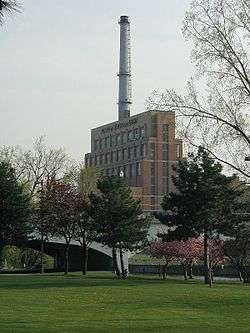
Lansing elevations range between 890 feet (271 m) above sea level on the far south side of Lansing along Northrup Street near the Cedar Street intersection, to 833 feet (254 m) to 805.5 feet (246 m) above sea level along the Grand River.
The Grand River, the largest river in Michigan, flows through downtown Lansing, and the Red Cedar River, a tributary of the Grand, flows through the campus of Michigan State University to its confluence with the Grand in Lansing. Sycamore Creek, a tributary of the Red Cedar, flows northward through the southeastern part of the city.[27] There are two lakes in the area, Park Lake and Lake Lansing, both northeast of the city. Lake Lansing is approximately 500 acres (2.0 km2) in size and is a summer favorite for swimmers, boaters, and fishermen. Michigan State University Sailing Club and the Lansing Sailing Club are located on Lake Lansing, where sailing regattas are hosted throughout the summer.
The City of Lansing operates a total of 3.55 square miles (9.2 km2) of parkland, of which 2.80 square miles (7.3 km2) is parkland, 0.43 square miles (1.1 km2) are golflands, and 0.31 square miles (0.80 km2) are cemetery lands.[28] However, this figure includes the Waverly Hills Golf Course and adjacent Michigan Avenue Park, whose 0.18 square miles (0.47 km2) are located within neighboring Lansing Township, but operated by the City of Lansing, and does not include the 0.18 square miles (0.47 km2) of the combined Hawk Island County Park and adjacent Soldan Dog Park operated by Ingham County within the city of Lansing.[29] All together then, 3.55 square miles (9.2 km2) of the city (or approximately 10%) is publicly administered open space.
Climate
Lansing has a Midwestern humid continental climate (Köppen Dfb/Dfa) that is influenced by the Great Lakes, and is part of USDA Hardiness zone 5b.[30] Winters are cold with moderate to heavy snowfall, while summers are very warm and humid. The monthly daily average temperature in July is 71.5 °F (21.9 °C), while the same figure for January is 23.4 °F (−4.8 °C); the annual mean is 48.21 °F (9.01 °C). On average, temperatures reach or exceed 90 °F (32.2 °C) on 8.8 days of the year and drop to or below 0 °F (−17.8 °C) on 10.5 nights.[31] Precipitation is generally greatest during summer but still frequent and significant in winter. Snowfall, which normally occurs from November to April, averages 51.1 inches (130 cm) per season, significantly less than areas to the west such as Grand Rapids as Lansing is relatively immune to lake-effect snows; seasonal snowfall has historically ranged from 16.6 in (42 cm) in 1863−64 to 97.2 in (247 cm) in 1880−81. The highest and lowest officially recorded temperatures were 103 °F (39 °C) on July 6, 2012,[31] and −37 °F (−38 °C) on February 2, 1868,[32] with the last −20 °F (−29 °C) or colder reading occurred on February 27, 1994; the record low maximum is −4 °F (−20 °C) on January 22, 1883, while, conversely, the record high minimum is 78 °F (26 °C) on August 1, 2006 and July 18, 1942.[31] Freezing temperatures in June are exceedingly rare and have not occurred in July or August since the 19th century; on average, they arrive on October 4 and depart on May 7, allowing a growing season of 149 days. The average window for measurable snow (≥0.1 in or 0.25 cm) is November 4 thru April 6.
| Climate data for Lansing, Michigan (Capital Region Int'l), 1981−2010 normals, extremes 1863−present[lower-alpha 3] | |||||||||||||
|---|---|---|---|---|---|---|---|---|---|---|---|---|---|
| Month | Jan | Feb | Mar | Apr | May | Jun | Jul | Aug | Sep | Oct | Nov | Dec | Year |
| Record high °F (°C) | 66 (19) |
69 (21) |
86 (30) |
88 (31) |
96 (36) |
99 (37) |
103 (39) |
102 (39) |
99 (37) |
90 (32) |
79 (26) |
70 (21) |
103 (39) |
| Mean maximum °F (°C) | 50.0 (10.0) |
52.0 (11.1) |
68.9 (20.5) |
79.3 (26.3) |
84.3 (29.1) |
91.4 (33.0) |
92.2 (33.4) |
91.4 (33.0) |
87.2 (30.7) |
77.9 (25.5) |
66.1 (18.9) |
52.5 (11.4) |
94.1 (34.5) |
| Average high °F (°C) | 30.1 (−1.1) |
33.3 (0.7) |
44.1 (6.7) |
57.8 (14.3) |
68.8 (20.4) |
78.4 (25.8) |
82.4 (28.0) |
80.1 (26.7) |
72.7 (22.6) |
59.9 (15.5) |
46.7 (8.2) |
34.3 (1.3) |
57.4 (14.1) |
| Daily mean °F (°C) | 23.4 (−4.8) |
25.9 (−3.4) |
35.1 (1.7) |
47.4 (8.6) |
57.7 (14.3) |
67.6 (19.8) |
71.5 (21.9) |
69.8 (21.0) |
61.9 (16.6) |
50.3 (10.2) |
39.6 (4.2) |
28.3 (−2.1) |
48.2 (9.0) |
| Average low °F (°C) | 16.8 (−8.4) |
18.5 (−7.5) |
26.0 (−3.3) |
37.0 (2.8) |
46.7 (8.2) |
56.7 (13.7) |
60.6 (15.9) |
59.4 (15.2) |
51.2 (10.7) |
40.7 (4.8) |
32.4 (0.2) |
22.3 (−5.4) |
39.0 (3.9) |
| Mean minimum °F (°C) | −7.5 (−21.9) |
−4.2 (−20.1) |
3.7 (−15.7) |
19.7 (−6.8) |
30.2 (−1.0) |
40.4 (4.7) |
45.1 (7.3) |
43.9 (6.6) |
34.0 (1.1) |
24.6 (−4.1) |
15.8 (−9.0) |
−0.1 (−17.8) |
−12.0 (−24.4) |
| Record low °F (°C) | −29 (−34) |
−37 (−38) |
−25 (−32) |
−6 (−21) |
19 (−7) |
27 (−3) |
31 (−1) |
26 (−3) |
19 (−7) |
10 (−12) |
−5 (−21) |
−25 (−32) |
−37 (−38) |
| Average precipitation inches (mm) | 1.65 (42) |
1.47 (37) |
2.06 (52) |
3.03 (77) |
3.36 (85) |
3.45 (88) |
2.84 (72) |
3.23 (82) |
3.50 (89) |
2.53 (64) |
2.78 (71) |
1.87 (47) |
31.77 (807) |
| Average snowfall inches (cm) | 13.8 (35) |
11.6 (29) |
7.0 (18) |
1.9 (4.8) |
trace | 0 (0) |
0 (0) |
0 (0) |
0 (0) |
0.4 (1.0) |
3.4 (8.6) |
13.0 (33) |
51.1 (130) |
| Average precipitation days (≥ 0.01 in) | 13.4 | 10.6 | 11.2 | 12.1 | 11.6 | 10.3 | 9.5 | 9.9 | 10.7 | 10.9 | 12.7 | 13.9 | 136.8 |
| Average snowy days (≥ 0.1 in) | 12.5 | 9.8 | 5.8 | 1.8 | 0 | 0 | 0 | 0 | 0 | 0.3 | 3.7 | 10.8 | 44.7 |
| Average relative humidity (%) | 78.8 | 76.2 | 73.3 | 67.6 | 66.7 | 69.0 | 71.0 | 74.9 | 77.5 | 76.1 | 78.6 | 81.1 | 74.2 |
| Mean monthly sunshine hours | 118.2 | 140.1 | 187.6 | 218.7 | 278.6 | 296.2 | 318.5 | 278.1 | 217.6 | 163.8 | 92.4 | 82.1 | 2,391.9 |
| Percent possible sunshine | 40 | 47 | 51 | 54 | 61 | 65 | 69 | 65 | 58 | 48 | 32 | 29 | 54 |
| Source: NOAA (relative humidity and sun 1961−1990)[31][33][34] | |||||||||||||
Neighborhoods
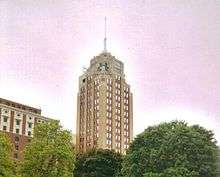
The city's downtown is dominated by state government buildings, especially the State Capitol; but downtown has also experienced recent growth in new restaurants, retail stores and residential developments. Downtown Lansing has a historic city market that is one of the oldest continuously operating farmers' markets in the United States.[35] Upriver and north of downtown is historic Old Town Lansing with many architecturally significant buildings dating to the mid-19th century.[36] Directly south of downtown on the other side of I-496 along Washington Avenue lies "REO Town", the birthplace of the automobile in the United States, is where Ransom Eli Olds built factories along Washington Avenue. Ransom Eli Olds' home, which once overlooked the factories along Washington Avenue, was displaced by I-496.
Lansing is generally divided into four sections: Eastside, Westside, Northwestside, and the Southside. Each section contains a diverse array of neighborhoods. The Eastside, located east of the Grand River and north of the Red Cedar River, is the most ethnically diverse side of Lansing, with foreign-born citizens making up more of its population than any other side in the city.[37] The Eastside's commercial districts are located mainly along Michigan Avenue, and to a lesser extent along Kalamazoo Street. It is anchored by Frandor Shopping Center on the very eastern edge of the eastside.
The Westside, roughly located north, west, and south of the Grand River as it curves through the city, is sometimes regarded the city's most socio-economically diverse section. This side also contains Lansing's downtown area, though this neighborhood is often included as an area all its own. Outside downtown, this side is largely a collection of residential neighborhoods and is served by only one other commercial area along Saginaw Street. However, it also includes a small part of the Old Town Commercial Association.
The Northwestside, generally located north of the Grand River, with the city limits defining its north and western borders, is physically the smallest side of the city. This part of the city includes moderate-density residential areas and some green areas. North of Grand River Avenue, the main street of the side, lie warehouses and light industrial areas served by a major rail line that runs through Lansing. The most notable landmark of this side is Lansing's airport: Capital Region International Airport.
The Southside, usually described as the neighborhoods located south of the Grand and Red Cedar rivers and the I-496 freeway, is physically the largest and most populous side of the city. The area is largely residential in nature (south of Mount Hope Road near the northern edge), and is served by numerous commercial strips along Cedar Street, Martin Luther King, Jr. Boulevard, Pennsylvania Avenue, and Waverly Road, which run north/south. The large Edgewood District is located in the southernmost part of the Southside and is sometimes referred to as South Lansing. Though it is the largest area of the city by both physical size and population, it has often been regarded by Southside citizens as Lansing's most overlooked and forgotten area, as most of Lansing's attention in recent decades has been put into the revitalization of the city's historic core located mostly on small parts of both the East and Westsides.
The middle of the Southside—South-Central Lansing—contains the Old Everett Area. This location once contained the Everett School District and was annexed into the city in 1948.[38]

Districts
- Cherry Hill
- Churchill Downs[39]
- Colonial Village
- Eastside[40]
- Edgewood
- Genesee
- Gier Park
- Hosmer
- Lansing-Eaton
- Moores Park
- Museum District
- Old Everett[41]
- Old Town
- REO Town
- Stadium District
- Walnut
- Washington Square
- Westside[42]
Demographics
| Historical population | |||
|---|---|---|---|
| Census | Pop. | %± | |
| 1850 | 1,299 | — | |
| 1860 | 3,074 | 136.6% | |
| 1870 | 5,241 | 70.5% | |
| 1880 | 8,319 | 58.7% | |
| 1890 | 13,102 | 57.5% | |
| 1900 | 16,485 | 25.8% | |
| 1910 | 31,229 | 89.4% | |
| 1920 | 57,327 | 83.6% | |
| 1930 | 78,397 | 36.8% | |
| 1940 | 78,753 | 0.5% | |
| 1950 | 92,129 | 17.0% | |
| 1960 | 107,807 | 17.0% | |
| 1970 | 131,403 | 21.9% | |
| 1980 | 130,414 | −0.8% | |
| 1990 | 127,321 | −2.4% | |
| 2000 | 119,128 | −6.4% | |
| 2010 | 114,297 | −4.1% | |
| Est. 2019 | 118,210 | [3] | 3.4% |
| U.S. Decennial Census[43] | |||
2010 census
As of the census[5] of 2010, there were 114,297 people, 48,450 households, and 26,234 families residing in the city. The population density was 3,174.9 per square mile (1,226.3/km2). There were 54,181 housing units at an average density of 1,505.0 per square mile (581.3/km2). The racial makeup of the city was 61.2% White (55.5% Non-Hispanic White), 23.7% African American, 0.8% Native American, 3.7% Asian, 0.04% Pacific Islander, 4.3% from other races, and 6.2% from two or more races. Hispanic or Latino of any race were 12.5% of the population. Foreign-born residents made up 8.3% of the population.
The median age in the city was 32.2 years. 24.2% of residents were under the age of 18; 12.3% were between the ages of 18 and 24; 30.2% were from 25 to 44; 23.8% were from 45 to 64; and 9.7% were 65 years of age or older. The gender makeup of the city was 48.4% male and 51.6% female.[2]
2000 census
As of the census[5] of 2000, there were 119,128 people, 49,505 households, and 28,366 families residing in the city. The population density was 3,399.0 per square mile (1,312.3/km2). There were 53,159 housing units at an average density of 1,516.8/sq mi (585.6/km2). The racial makeup of the city was 65.28% White (61.4% non-Hispanic White), 21.91% African American, 0.80% Native American, 2.83% Asian, 0.05% Pacific Islander, 4.54% from other races, and 4.60% from two or more races. Hispanic or Latino of any race were 10.0% of the population. The city's foreign-born population stood at 5.9%.
As of 2000, the city's population rose by 32,293 (27%) to 151,421 during the day due to the influx of workers.[44]
There were 49,505 households, out of which 30.0% had children under the age of 18 living with them, 35.8% were married couples living together, 17.0% had a female householder with no husband present, and 42.7% were non-families. 33.2% of all households were made up of individuals, and 8.1% had someone living alone who was 65 years of age or older. The average household size was 2.39 and the average family size was 3.08.
In the city, the population was spread out, with 26.8% under the age of 18, 11.4% from 18 to 24, 32.7% from 25 to 44, 19.3% from 45 to 64, and 9.7% who were 65 years of age or older. The median age was 31 years. For every 100 females, there were 92.3 males. For every 100 females age 18 and over, there were 87.9 males.
The median income for a household in the city was $34,833, and the median income for a family was $41,283. Males had a median income of $32,648 versus $27,051 for females. The per capita income for the city was $17,924. About 13.2% of families and 16.9% of the population were below the poverty line, including 23.2% of those under age 18 and 9.0% of those age 65 or over.
Immigration and refugee resettlement
The Brookings Institution has ranked Greater Lansing among the top 10 "medium-sized metropolitan areas" in the United States for refugee resettlement, with 5,369 refugees resettled from 1983 to 2004.[45] St. Vincent Catholic Charities and Lutheran Social Services handle the adult and unaccompanied minor resettlement processes, respectively, while other organizations, such as the Refugee Development Center, focus on providing educational and social support services to refugees in the Lansing area.[46] Nearby Michigan State University provides a source of volunteers for many of these programs.[47][48]
As of 2005, the Lansing area has about 2,000 Arab Americans, mostly second generation Christian Lebanese Americans as well as some Palestinian Americans.[49]
The city is also home to a large number of temporary foreign residents enrolled as international students at Lansing Community College and nearby Michigan State University, with the city's visitors bureau specifically promoting Mandarin-language video tours of Lansing, touting the "more than 6,000" Chinese students enrolled at MSU.[50] The Lansing School District offers language immersion programs for its students in both Spanish and Chinese.[51]
Government
Lansing is administered under a mayor–council government, more specifically a strong mayor form in which the mayor is the city's chief executive officer.[52] The mayor is obligated to appoint department heads (subject to council approval), and draft and administer a city budget among other responsibilities. The mayor may also veto legislation from council, though the veto can be overridden by an affirmative vote of two-thirds of the council.[52] The mayor and city clerk are elected at-large every four years.
The city council is the legislative body of the city and consists of eight members. Four members are elected from four single-member districts using the first-past-the-post method in the city's wards, and four members are elected at-large using the block voting method. Members of the council serve staggered four-year terms.[53] Half the council is up for election every two years, including two ward seats and two at-large seats.[54] At its first meeting of the year, the council chooses from amongst its members a president and vice president. The president is the council's presiding officer, and also chooses the chairs of council committees.[52] In the absence of the president and vice president, the city clerk chairs the council.
The city largely supports the Democratic Party. It has not had a Republican mayor in office since 1993 when then-Democratic state representative David Hollister defeated incumbent Mayor Jim Crawford, who had formerly served as a Republican member on the Ingham County Board of Commissioners. However, all city elections are held on an officially nonpartisan basis.[52]
Since given the ability to do so by the state in 1964, the city has levied an income tax of 1 percent on residents. 0.5 percent on non-residents, and 1.0 percent on corporations.[55][56]
State and federal representation
Lansing is currently split between three congressional districts. Most of the city lies within the boundaries of Michigan's 8th congressional district, which is represented by Democratic congresswoman Elissa Slotkin, who was elected in the 2018 midterm election. The small portion of the city that extends into Eaton County is located in Michigan's 7th congressional district, which has been represented by Republican congressman Tim Walberg since 2011. The small portion of the city that extends into Clinton County is located in Michigan's 4th congressional district, which has been represented by Republican congressman John Moolenaar since 2015.
At the state level, most of Lansing is located in the 23rd district of the Michigan Senate, which has been represented by Democratic state senator Curtis Hertel Jr. since 2015. The small portions of the city that extend into Eaton County and Clinton County is located in the 24th district of the Michigan Senate, are currently represented by Republican state senator Tom Barrett. The city lies in the 67th, 68th, 71st, and 93rd districts of the Michigan State House of Representatives, represented by state representatives Kara Hope (D-67), Sarah Anthony (D-68), Angela Witwer (D-71), and Graham Filler (R-93).
Though Lansing is not the designated county seat, some Ingham County offices are located in downtown Lansing, including a branch office of the county clerk, the county personnel office, and some courtrooms.
Economy
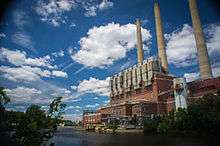
| Top City Employers Source: Lansing Economic Area Partnership[57] | |||||
| Rank | Company/Organization | # | |||
| 1 | State of Michigan | 14,390 | |||
| 2 | Michigan State University | 10,253 | |||
| 3 | Sparrow Health System | 7,600 | |||
| 4 | General Motors | 4,549 | |||
| 5 | Lansing Community College | 3,144 | |||
| 6 | McLaren Greater Lansing | 3,000 | |||
| 7 | Auto-Owners Insurance | 2,578 | |||
| 8 | Peckham | 2,510 | |||
| 9 | Jackson National Life | 2,500 | |||
| 10 | Dart Container | 2,000 | |||
| 11 | Meijer | 1,500 | |||
| 12 | Dean Transportation | 800 | |||
| 13 | Delta Dental | 800 | |||
| 14 | MSU Federal Credit Union | 800 | |||
| 15 | Michigan Farm Bureau | 750 | |||
The Lansing metropolitan area's major industries are government, education, insurance, healthcare, and automobile manufacturing. Being the state capital, many state government workers reside in the area.
Michigan State University, Thomas M. Cooley Law School, and Lansing Community College are significant employers in the region.
General Motors has offices and a hi-tech manufacturing facility in Lansing and several manufacturing facilities immediately outside the city, as well, in nearby Lansing and Delta townships. The Lansing area is headquarters to four major national insurance companies: Auto-Owners Insurance Company, Jackson National Life, the Accident Fund, and Michigan Millers Insurance Company. Other insurers based in Lansing include Farm Bureau Insurance of Michigan.
Locally owned and operated convenience store chain Quality Dairy is a significant presence in the Lansing market.
The recent decline of the auto industry in the region has increased the region's awareness of the importance of a strategy to foster the high-technology sector.
Early availability of high-speed Internet in 1996, as well as the MSU, Cooley Law School, and Lansing Community College student body population, fostered an intellectual environment for information technology companies to incubate. Lansing has a number of technology companies in the fields of information technology and biotechnology.
Healthcare
Sparrow Hospital is a 740-bed hospital affiliated with Michigan State University and its College of Human Medicine and College of Osteopathic Medicine. In February 2009 it was announced that Sparrow and MSU formalized their partnership to increase research and faculty recruitment.[58] Sparrow Hospital is the Regional Center for pediatrics, cancer care, including radiation therapy, trauma care, neurological care, high-risk obstetrics and neonatal intensive care. The Sparrow Tower was finished January 2008 and includes but is not limited to: a dedicated pediatric emergency room (the only one in the region), the largest adult emergency room in the region, state-of-the-art operating rooms, a rooftop helipad, oncology center, heart and vascular center and orthopedic department. In addition, 4,500 deliveries are performed at Sparrow Hospital annually, rehabilitation, and emergency treatment is more than any other hospital in mid-Michigan. The Sparrow Health System Laboratory performs over 3 million tests per year, at various laboratory sites, which include four remote testing facilities and thirteen patient service centers. Sparrow Hospital is certified as a Level I Trauma Center by the American College of Surgeons.[59] In May 2009 Sparrow announced that it now has its own helicopter service based at its downtown Lansing hospital's new $2.5 million helipad.[60] The addition is expected to increase helicopter patient transport to the hospital from four a month to 400 a year.
McLaren–Greater Lansing Hospital is also a university affiliated teaching hospital. Ingham enjoys a special affiliation in radiation oncology with the University of Michigan and Michigan State University; McLaren–Greater Lansing is part of the Great Lakes Cancer Institute (GLCI). McLaren received five-star ratings for: Coronary bypass surgery; Cardiac interventions; Treatment of heart attacks; Total knee replacement; Total hip replacement; Back and neck surgery; Chronic obstructive pulmonary disease care; Community-Acquired pneumonia care.[61]
Urban renewal and downtown redevelopment
Several urban renewal projects by private developers are adding higher end apartments and condominiums to the Lansing market. The Arbaugh, a former department store across from Cooley Law School, was converted into apartments in 2005. Motor Wheel Lofts, a former industrial site, was converted into loft-style living spaces in mid-2006.[62] A combination retail and residential complex immediately south of Cooley Law School Stadium (formerly Oldsmobile Park) called "The Stadium District", was completed in 2007.[63] The Stadium District was redeveloped using a grant from the Michigan State Housing Development Authority through the Cool Cities Initiative.[64][65]
In May 2006 the historically significant Mutual Building located on Capitol Avenue was purchased by The Christman Company to be renovated back to its original grandeur and used as the company's headquarters.[66] Additional downtown developments include the renovation of the historic Hollister Building and the expansion of the former Abrams Aerial Building. As of August 2008, an 18-story condominium high-rise called Capitol Club Tower was in the design phase with the adjacent parking structure having been approved by city council and purchased by the developer. The city market, in existence since 1909, was approved to be sold for a multi-building mixed-use development called MarketPlace, right next to the current market on the adjacent riverfront. The MarketPlace project was redeveloped along with BallPark North, another mixed-use development that will be immediately north of Oldsmobile Stadium. The new city market is just north of the Lansing Center, across the river from where the Accident Fund Insurance Company renovated the former (art deco) Ottawa Street Powerplant into their new headquarters. In addition to the renovation, Accident Fund Insurance Company built a modern addition to the north of the historic portion that is connected by an atrium for more office space, as well as a parking structure. In 2009, the restaurant Troppo began construction on a new 2-story building that will have an open air patio on the roof facing the Capitol building.[67] Developer Eyde Co. announced plans on April 6, 2010, to renovate the historical and prominent Knapp's building in downtown Lansing for first floor retail, office space and apartments/condos on the top floor (5th) in a $22–24 million project.[68]
Retail
The Lansing area has two major malls: Lansing Mall and Meridian Mall. Other major retail centers include Eastwood Towne Center and Frandor Shopping Center.
Education
Westside Lansing
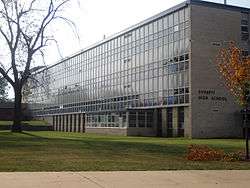
Southside Lansing
Michigan State University, a member of the Big Ten Conference, is known as "the pioneer land grant college", located in neighboring East Lansing. MSU has the largest land campus in the United States and is home to several nationally and internationally recognized academic and research oriented programs. Michigan State offers over 200 programs of study and is home to fourteen different degree-granting schools and colleges including two medical schools, a veterinary school, a law school, and numerous PhD programs. It is the only university in the nation with three medical schools. MSU is consistently one of the top three programs in the United States for study abroad programs. The MSU College of Education is also consistently rated as the top education program in the nation. Michigan State University is the oldest agricultural college in the United States. The MSU School of Criminal Justice is the oldest continuous degree granting criminal justice program in the nation.[69] In 2008, the Department of Energy announced MSU won the contest for a $550 million Facility for Rare Isotope Beams that will attract top researchers from around the world to conduct experiments in nuclear science, astrophysics and applications of isotopes to other fields.[70]
The Thomas M. Cooley Law School is the largest law school in the nation and is located in downtown Lansing. Cooley is fully accredited by the American Bar Association. A majority of Cooley students are from out-of-state.
Lansing Community College offers more than 500 areas of study to over 18,000 students at its main facilities in Lansing, and another 5,000 students at twenty-nine extension centers and a site in Otsu, Japan. LCC's new, state-of-the-art University Center enables students to take courses with the goal of eventually earning an undergraduate or graduate degree from other Michigan institutions. The University Center stands on the former site of "Old Central", Lansing's first public high school, which was established in 1875 as Lansing High School. (In the 1920s it was renamed as Central High School, and in 1957 became the first building on the LCC campus.)[71]
Other institutions of higher education include Western Michigan University (branch campus in Delta Township), Davenport University in Downtown Lansing, Central Michigan University (branch campus), and Great Lakes Christian College (campus in Delta Township).
Eastside Lansing
Schools
- Public schools
- Lansing School District[72]
- Grand Ledge Public Schools[73]
- Ingham Intermediate School District[74]
- Mid-Michigan Public School Academy
- Shabazz Public School Academy (named after Malcolm X)
- Waverly School District
- Private schools
- Capitol City Baptist School
- Emanuel Lutheran School [75]
- Lansing Catholic High School
- Lansing Christian Schools[76]
- New Covenant Christian School[77]
- Our Savior Lutheran School[78]
Cultural celebrations
Parades
Each year in August, the Michigan Pride festival includes a LGBT pride parade from Riverfront Park to the capitol.
The Capital City African American Cultural Association hosts an African American Parade and Heritage Festival every year for over a decade. The chair of the CCAACA is the Rev. Dr. Michael C. Murphy, who was pastor of St. Stephen's Community Church and is currently the pastor of Peoples Congregational, United Church of Christ, Washington D.C. He is a former State Representative for the 68th House District in Michigan, former President of the Lansing City Council, and a long-time community leader. The parade highlights African American culture, its influence in Michigan, and recognizes prominent African American individuals in the community and their contributions to Lansing as the grand marshal of each parade. The festival immediately following the parade consists of live entertainment, soul food and lots of fun for adults and children. It is held every year on the first Saturday in August and begins at 11:00 a.m. in downtown Lansing, Michigan. The festival is held at Ferris Park in downtown Lansing. In 2009 they celebrated 10 years.
The annual Silver Bells in the City Electric Light Parade proceeds through the streets of downtown Lansing every November, the Friday before Thanksgiving. It is followed by the lighting of Michigan's official Christmas tree in front of the State Capitol and a firework show (weather permitting) over the State Capitol.[79]
Music
The Lansing Symphony Orchestra has been entertaining generations of Lansing-area residents since 1929. The current music director is Timothy Muffett.
The Lansing JazzFest and the Old Town BluesFest host leading musicians, and are two of the larger music festivals held each year in the state.
Old Town's Festival of the Moon and Sun is a two-day festival of food and live music.[80]
Old Town Oktoberfest is a two-day event drawing hundreds to the Old Town neighborhood for live polka music, authentic German food and world-renowned German-style beer.[81]
It was announced in May 2007 that the city would host "Blues on the Square", a series of summertime blues concerts featuring national acts Thursday nights along Washington Square in downtown Lansing. In 2008 the event regularly drew crowds over 500.[82]
The Common Ground Festival[83] is a musical event held over a week every July at the Adado Riverfront Park in downtown Lansing pulling in crowds over 90,000 for the week. It began in 2000 and replaced the Michigan Festival that was held in nearby East Lansing. It has wide range of musical acts. In 2008 acts included Staind, Drowning Pool, Sammy Hagar, The Hard Lessons, Snoop Dogg, REO Speedwagon, Kellie Pickler, Seether and Trace Adkins. 2012 acts included The Flaming Lips, Man Man, Motion City Soundtrack, Joshua Davis, mewithoutyou, with local ensembles The Lansing Unionized Vaudeville Spectacle and Vandalay on the bill.
Every year City Pulse names the "Top Original Act" in the Top of the Town Awards. The 2010 winner was Eastside neighborhood native indie rock band Loune.[84] The 2011 winner was pop punk act Frank and Earnest.[85]
On June 23, 2018, REO Town hosted the Three Stacks Music Festival featuring Against Me!, Murder by Death, Pup, mewithoutyou, Screaming Females, Camp Cove, Petal, Oceanator, City Mouse, Worn Spirit, Stefanie Haapala, Ness Lake, and Secret Forte.
Other notable Lansing musicians include Tell Yo Mama, Root Doctor, Jen Sygit, James Gardin, The Further Adventures of Fat Boy and the Jive Turkeys, MSU Professors of Jazz, Joe Hertler and the Rainbow Seekers, Jahshua Smith, BLAT! Pack, Deacon Earl and Frontier Ruckus.
Points of interest
Farmers' markets

Lansing has several farmers' markets throughout the city in the summer months. These markets include the Allen Street Farmer's Market[86] on the city's eastside, the Westside Farmers' Market, the Old Town Farmer's Market, the South Lansing Farmer's Market,[87] and the year-round historic Lansing City Market[35] located near downtown. The Lansing City Market has built a brand new $1.6 million facility on the riverfront in downtown Lansing where it will continue its year round operations providing specialty items in addition to regular groceries from over 30 vendors.
Libraries
The Library of Michigan and Historical Center is a highly regarded state library and research center. The library is one of the top five genealogical research facilities in the United States. The Capital Area District Library has 13 branches within Ingham County, some of these include: The Main library downtown, the Foster Library on the east side, and the South Lansing Library on the south side.
Lansing Art Gallery
The Lansing Art Gallery, founded in 1965, is Lansing's oldest art gallery and a non-profit membership organization. Showcasing the works of Michigan artists, the gallery is committed to providing cultural enhancement opportunities for Michigan residents. The museum is open to the public with free admission.
Museums
Lansing is home to a number of small, specialized museums:
- The Impression 5 Science Center[88] is a children's science center located in a historic wagon works factory on the Grand River.
- The Michigan Library and Historical Center contains one of the 10 largest genealogy collections in the nation, has a museum dedicated to Michigan's history among other attractions.[89]
- The Michigan Women's Hall of Fame is a museum dedicated to the historical accomplishments and achievements of Michigan women. The house is located directly south of downtown in the 1903-built Cooley-Haze House. The museum is surrounded by Cooley Gardens.[90]
- The R. E. Olds Transportation Museum is dedicated to the education of Lansing's role in the development of transportation, particularly the automobile.
- The Turner-Dodge House[91] is a museum dedicated to Lansing's early pioneers. The museum sits in the Classical Revival-styled Turner-Dodge Mansion, built in 1858 for James and Marion Turner, and later by their daughter and her husband. It is on the National Register of Historic Places.
Theatre
- The Riverwalk Theatre,[92] (formerly the Okemos Barn Theatre), the Lansing Civic Players,[93] and the now defunct BoarsHead Theater[94] are or were all located in downtown.
- Peppermint Creek Theatre Company[95] is a well established "new" award-winning theater company.
- Happendance, Michigan's longest-running professional modern dance company, has been based in Greater Lansing since 1976.[96]
- The Greater Lansing Ballet Company is an award-winning ballet and dance company.
- The Creole Gallery[97] brings in various musicians and hosts the Icarus Falling Theater group.
Potter Park Zoo
The historic Potter Park Zoo, located along the Red Cedar River in Lansing, is a 102 acre park that has more than 160 species of animals. The park holds numerous programs and events for children and families to enjoy. With annual attendance increasing every year since 2006 (110,167 in 2006, 137,237 in 2008, and 167,000 in 2009) there are $667,100 in capital improvements planned for 2009 including a giant walk-in aviary and a new female tiger. In 2009 the zoo began a $1.4 million renovation to its rhinoceros exhibit. This is in addition to $1.3 million spent on capital improvements in 2008.[98][99] In 2011 the Black Rhino exhibit opened; and three tiger cubs were born. In 2016 a 3 acre moose exhibit opened in the park.[100]
Other area destinations
In October 2009 the Wharton Center for Performing Arts completed a 24,000 square feet (2,230 m2), $18.5 million expansion and renovation,[101] having already spent over $1.3 million in 2008.[102] Many Broadway shows come to The Wharton Center before traveling to theaters in larger places such as Chicago.[103] The Kresge Art Museum,[104] the MSU Museum,[105] and the Abrams Planetarium[106] are highly acclaimed cultural destinations located on the campus of Michigan State University in East Lansing. In June 2007 MSU announced the plans to build a new art museum after a $26 million gift from Eli and Edythe Broad.[107] Internationally known Pritzker Prize winning architect Zaha Hadid of London won the design competition for the East Lansing museum that was completed in November 2012.
Media
Newspapers and magazines
- Lansing State Journal
- City Pulse[108]
- The New Citizens Press[109]
- Capital Gains Media[110]
- Capital Area Women's Lifestyle Magazine[111]
- The Greater Lansing Business Monthly[112]
- Greater Lansing Woman Magazine[113]
- The Hub[114]
- MIRS News-Michigan Information & Research Service[115]
- The State News
- Gongwer News Service[116]
- The Michigan Bulletin[117]
- Patient In Charge Magazine[118]
Television
Cable slots listed reflect the Comcast cable system in Lansing.
- WLNS 6 (CBS) (Cable 9)
- WILX 10 (NBC) (Cable 4)
- WKAR 23 (PBS) (Cable 13) / DT2 (World) (Cable 20) / DT3 (Create) (Cable 18) / DT4 (PBS Kids) (Cable 293)
- WSYM 47 (Fox) (Cable 7)
- WLAJ 53 (ABC) (Cable 3) / DT2 (CW) (Cable 5)
WILX maintains WSYM's News programming. Both affiliates broadcast their newscasts at the News 10 studios in Lansing. Often the same reporters are used on both broadcasts.
Radio
Note: If the station has no city listed before the format, it is licensed to Lansing.
- 88.1 WLGH – (Leroy Township, contemporary Christian) "Smile FM"
- 88.5 WJOM – (Eagle, contemporary Christian) "Smile FM"
- 88.9 WDBM – (East Lansing, college/Michigan State University) "The Impact"
- 89.7 WLNZ – (public radio/Lansing Community College)
- 90.5 WKAR – (East Lansing, public radio/Michigan State University)
- Note: WKAR has an effective radiated power of 86,000 watts
- 91.3 WOES – (Ovid, polka/Ovid-Elsie High School)
- 92.1 WQTX – (St. Johns, sports talk) "The Team"
- 92.9 WLMI – (Grand Ledge, CHR) "Lansing's New Hits"
- 93.7 WBCT-FM – (Grand Rapids, country) "B93"
- Note: WBCT has an effective radiated power 320,000 watts
- 94.1 WWDK – (Jackson, Classic Country) "94.1 Duke FM"
- 94.9 WMMQ – (East Lansing, classic rock)
- 96.5 WQHH – (DeWitt, urban) "Power 96.5"
- 97.5 WJIM – (CHR) "97-5 Now-FM"
- 99.1 WFMK – (East Lansing, adult contemporary)
- 99.9 W260BX - (religious/southern gospel) "Family Life Radio"
- Rebroadcasts WUNN 1110 AM.
- 100.7 WITL-FM – (country) "Whittle"
- 101.7 WHZZ – (adult hits) "Mike-FM"
- 105.7 WSRW – (Grand Rapids, adult contemporary) "Star 105.7"
- 106.1 WJXQ – (Charlotte, active rock) "Q106"
- 107.3 WTNR – (Greenville/Grand Rapids, Country)
- 730 AM WVFN – (East Lansing, sports talk) "The Game"
- 870 AM WKAR – (East Lansing, NPR news/talk)
- 1110 AM WUNN – (Mason, religious/southern gospel) "Family Life Radio"
- 1180 AM WXLA – Dimondale, (adult standards) "Timeless Classics 1180"
- 1240 AM WJIM – (news/talk) "Lansing's Big Talker"
- 1320 AM WILS – (news/talk) "More Compelling Talk Radio”
- 1390 AM WLCM – (Charlotte, religious)
- 1580 AM WWSJ – (St. Johns, urban contemporary gospel) "Joy 1580"
- 162.400 WXK81 – NOAA Weather Radio (Onondaga, weather)
Radio stations from Ann Arbor, Grand Rapids, Kalamazoo, Saginaw, and Flint can also be heard in the Lansing area.
Sports
| Club | Sport | League | Venue | Years of Existence |
| Lansing Lugnuts | Baseball | Midwest League (Class-A) | Cooley Law School Stadium | 1996–present |
| Lansing Capitals | Basketball | Independent Basketball Association | Aim High Sports | |
| Lansing Sting | Basketball | American Basketball Association | Aim High Sports | |
| Michigan State Spartans | College athletics | Big Ten Conference | Various Stadiums | |
| Lansing Community College | College athletics | Michigan Community College Athletic Association | Aim High Sports | |
| Lansing Derby Vixens | Roller derby | Women's Flat Track Derby Association | Lansing Center | |
| Capital City Stealth | Football | Great Lakes Football League | Hope Sports Complex | 2010–present |
| Lansing Ignite FC | Soccer | USL League One | Cooley Law School Stadium | 2019 |
| Lansing United[119] | Soccer | USL PDL | Archer Stadium, DeMartin Stadium | |
| Lansing Hot Rods | Indoor Lacrosse | Continental Indoor Lacrosse League | Lansing SoccerZone | 2013–present |
The Lansing Lugnuts are a Class A Midwest League, Minor League Baseball team, currently affiliated with the Toronto Blue Jays. The team plays its home games at Cooley Law School Stadium, which was built at a cost of $12.7 million and opened in 1996 in downtown Lansing. It was partially renovated in 2006. Cooley Law School Stadium has a seating capacity of 11,215 fans, and was built to accommodate additional expansion. The team has won two Midwest League championships, their first in 1997 and their second in 2003. Previously known as Oldsmobile Park, the facility was renamed Thomas M. Cooley Law School Stadium in April 2010, in reference to the park's new sponsor.[120]
The Summit at the Capital Centre is a hockey arena and convention center located in the suburb of Dimondale that hosts youth and high school hockey.
The Lansing Capitals began play in the International Basketball League in 2006 but eventually disband for a few seasons. The team recently resumed playing in the newly formed Independent Basketball Association in 2011.
Michigan State University, located in East Lansing, is the largest university in the State of Michigan. MSU sponsors both men's and women's sports, usually competing as a member of the Big Ten Conference. The Spartans have won National Titles in Men's Basketball, Football, Men's Boxing, Men's Cross Country, Men's Gymnastics, Men's Ice Hockey, Men's Soccer, and Men's Wrestling.
On November 27, 2011, MSU beat Northwestern in their Big Ten Football finale to secure the top Big Ten record at 7-1 in conference play, and qualified to play in the first ever Big Ten Football Championship Game[121] which was held December 3, 2011, at Lucas Stadium in Indianapolis, Indiana against the Wisconsin Badgers.
Lansing Community College also sponsors many sports, competing as members of the Michigan Community College Athletic Association. The Stars have won NJCAA titles in the following sports: Women's Softball, Men's Basketball, Women's Basketball, Men's Cross Country, Women's Cross Country, Women's Marathon and Men's Marathon.
The Lansing area is also known for its many golf courses, with two courses owned by Michigan State University, four municipal courses, and many additional public and private courses in the area. Walnut Hills Country Club in nearby East Lansing formerly hosted the LPGA's Oldsmobile Classic from 1992 to 2000. The Michigan PGA recently relocated from the Detroit area to Bath, Michigan, which is on the northern edge of Lansing.
The Capital City Stealth, Lansing's Semi-pro Football team was founded in 2010. The Stealth have posted winning seasons in every year of their existence. They play in the Great Lakes Football League which is nationally known as one of the top leagues in the country. The Stealth appeared in the USFA AA National Championship game for 3 straight seasons from 2012-2014 and won the USFA AA National Championship in 2014 over the Pioneer Valley Knights (New England Football League) by the score of 22-13.[122] The team is made up of Lansing area athletes who play for the love of the game - none of the Stealth coaches or players are paid.[123]
In the 1980s and 1990s Lansing was a major player in semi-pro football. The Lansing Crusaders won MFL/MCFL championships in 1982, 1983, 1985, 1987, 1989, and 1990. The team finished second in 1984, 1986, and 1991.
Other past sports teams include:
- Lansing – Michigan State League (baseball) – 1889 to 1890
- Lansing Senators – Michigan State League (baseball) – 1895 and 1902
- Southern Michigan League – 1907 to 1914
- Central League – 1921 to 1922
- renamed the Lansing Lancers – Michigan State League – 1940
- and then back as the Lansing Senators – Michigan State League – 1941
- Lansing Capitals – North American Basketball League – 1966–67 to 1967–68
- Lansing Lancers – International Hockey League – 1974 to 1975
- Capital City Cardinals – Michigan Charity Football League – 1980
- Lansing Crusaders – Michigan Charity Football League – 1980 to 1988
- Michigan Football League – 1989 to 1994
- Capital City Cowboys – Michigan Football League – 1992
- Lansing Ice Nuts – International Independent Hockey League – 2003 to 2004
Transportation
Airports
Scheduled commercial airline service is offered from Capital Region International Airport (formerly known as Capital City Airport).[124] Delta Air Lines maintains routes to Detroit and Minneapolis. United Airlines maintains routes to Chicago O'Hare. American Airlines offers non-stop flights to Washington, D.C. and Chicago O'Hare. Apple Vacations provides seasonal flights to Cancún, Mexico; Montego Bay, Jamaica; and Punta Cana, Dominican Republic.[125] UPS has a freight hub at Capital Region International Airport making up part of the 42 million pounds of annual cargo moving through the airport.[126] In 2008 the airport received a port of entry designation – known as Port Lansing – and now has a permanent customs facility, thus changing its name to reflect the port of entry status.[127] The same year a 500-foot (150 m) extension to the largest of the three runways – now 8,506-foot (2,593 m) – was completed to allow for larger aircraft to use the airport.[128]
Major highways









Railways
- Amtrak provides intercity passenger rail service at a stop in nearby East Lansing, on the Blue Water line from Chicago to Port Huron.
- Three freight railroads serve Lansing including Canadian National Railway, CSX Transportation, and the Jackson & Lansing Railroad.
Public transportation
- Capital Area Transportation Authority (CATA) provides public transit bus service to the Lansing-East Lansing Metropolitan area on 33 routes. CATA boasts the second highest ridership in the state of Michigan after Detroit with 53,000 daily rides in September 2008 and 11,306,339 rides in fiscal year 2008.[129] CATA also provides paratransit services through Spec-Tran and the "Night Owl." Also, the "Entertainment Express" (CATA route 4) runs Thursday through Saturday from 7 pm to 2 am connecting downtown Lansing's and East Lansing's entertainment districts. CATA won APTA's America's Best Transit Award in the medium-size category (4–30 million rides) in 2007. CATA has two transportation centers (CTC), one in downtown Lansing and one on the campus of Michigan State University. In 2010, a study was conducted to consider ways of enhancing the Lansing-to-East Lansing route (currently known as Route 1), with options including enhanced bus service, single-car trolley service and light rail service. (Heavy rail was eliminated as an option early in the process, with enhanced bus service eventually winning out.)
- Greyhound Lines provides inter-city bus service. CATA and Greyhound are both located in the CATA Transportation Center (CTC) in downtown Lansing.
- Several taxicab companies serve the area. In 2001, Big Daddy Taxi opened using large vans to address the safety concerns of drunk driving and offered $3 rides for students of Michigan State University. In 2008 the Green Cab Company opened using Toyota Prius hybrid cars to provide "green" cabs to Lansing.[130]
- The Michigan Flyer provides bus service between Lansing and Detroit Metro Airport 12 times daily, with a stop in Ann Arbor along the way.
Bicycling
- The 13-mile (21 km), non-motorized Lansing River Trail runs along the Grand River and the Red Cedar River, running as far east as Michigan State University, and passes Potter Park Zoo, the Capitol Loop, and several other destinations of interest, and as far west as Moores Park. The trail is accessible at many points along it, some with car parking lots. The trails breadth is extended from time to time. Currently, the trailheads are:[131] North - Dietrich Park; East - Kircher Park; South - Maguire Park; West - Moores Park. All segments are hard-surfaced. The River Trail connects to other pathways/trails in the Lansing-metro area: East - Michigan State University path system; South - Sycamore Trail. Since the trail follows a river, most street crossings use platforms under existing street bridges to provide an uncommon amount of grade separation, to the benefit of both trail users and automobile traffic. As of February 2015, the River Trail is under construction to add paths as far as Holt.
Utilities
Water supply, power and steam are municipally owned utilities which are provided by Lansing Board of Water & Light. In 2008 the Lansing BWL constructed Michigan's largest solar array towards the goal of increasing renewable energy in the energy grid.[132]
Natural gas is provided by Consumers Energy.
Notable people
- Joel Bakan, Canadian law professor and documentary filmmaker
- Ray Stannard Baker, journalist and author
- L. Anna Ballard, first female medical physician in Lansing, Michigan
- Terry Brunk, ex-WWE, ECW, TNA/WCW professional wrestler known as "Sabu"
- Timothy Busfield, actor and director, thirtysomething, Field of Dreams, West Wing
- Charles G. Callard, co-founder of Callard Madden & Associates and a pioneer developer of corporate valuation models
- Jim Cash, screenwriter of Top Gun and other commercially successful films
- Carolyn Cassady, writer, wife of beat generation icon Neal Cassady
- Doc Corbin Dart, singer of punk band The Crucifucks
- DJ Infamous, hip-hop DJ
- Tony Earl, former Governor of Wisconsin
- Ed Emshwiller, visual artist and founder of CalArts computer animation Lab
- Rashad Evans, UFC fighter
- David Fairchild, botanist
- Ed Farhat, professional wrestler known as "The Sheik"
- Bryn Forbes, NBA basketball player
- Chris Hansen, Dateline NBC correspondent
- Thom Hartmann, radio talk-show host and author
- Ahney Her, actress, Gran Torino[133]
- Joel Higgins, actor, graduated from Michigan State
- Andy Hilbert, NHL hockey player
- Keiffer Hubbell, figure skater
- Madison Hubbell, figure skater
- Steve Huffman, American entrepreneur and web developer, CEO and co-founder of Reddit and also co-founded the now defunct airfare search site Hipmunk.[134]
- John Hughes, film writer and director, born in Lansing
- Carol Hutchins, softball Hall of Famer
- Magic Johnson, Michigan State University and NBA basketball star, Hall of Famer, president of Los Angeles Lakers, co-owner of Los Angeles Dodgers
- Jacquelyn Kelley, All-American Girls Professional Baseball League player
- Michael Kimball, novelist
- Lisa Kron, theatre actress and playwright
- Matthew Lillard, actor
- Dean Look, football player and official
- Malcolm X, human rights activist
- Jef Mallett, creator and artist of the comic strip Frazz[135]
- Suzanne Malveaux, CNN television news reporter
- Todd Martin, tennis player
- Pop McKale, athlete and coach; University of Arizona arena bears his name
- Drew Miller, NHL hockey player
- Kelly Miller, NHL player, ranks third all-time for the Washington Capitals in games played
- Kip Miller, NHL player, 1990 recipient of Hobey Baker Memorial Award
- Ryan Miller, NHL and Olympic hockey player
- Muhsin Muhammad, NFL football player
- Needlz, hip-hop and rap producer
- Ransom E. Olds, automobile manufacturer, founded Olds Motor Vehicle Company
- Larry Page, co-founder of Google.com
- DJ Perry, film writer, actor and director, born in Lansing
- Alice Pollitt, All-American Girls Professional Baseball League player
- Corey Potter, NHL hockey player
- Merv Pregulman, NFL player for Green Bay Packers, Detroit Lions
- Greg Raymer, 2004 World Series of Poker champion
- Carl Benton Reid, actor
- Burt Reynolds, Oscar-nominated and Golden Globe award-winning actor, film and television star, born and raised in Lansing
- Vic Saier, MLB player
- Steven Seagal, actor and martial artist, born in Lansing
- Frederic L. Smith, co-founder of General Motors, born in Lansing
- John Smoltz, MLB pitcher, 1996 Cy Young Award winner, Hall of Famer
- Jim "Soni" Sonefeld, drummer and percussionist for Hootie & the Blowfish
- Lori Nelson Spielman, Author of the best seller Life List
- Debbie Stabenow, U.S. senator
- Gary Starkweather, Inventor of the laser printer
- Marcus Taylor, professional basketball player
- George Teague, NFL player for Green Bay Packers, Dallas Cowboys, Miami Dolphins
- Denzel Valentine, professional basketball player
- Jay Vincent, professional basketball player
- Sam Vincent, professional basketball player
- Gretchen Whitmer, Governor of Michigan and former Minority Leader of the Michigan State Senate
- Howard Wolpe, Congressman who was a Lansing resident during his term in office.[136]
- Lebbeus Woods, architect.
International relations
Sister cities
Lansing has six sister cities, as designated by Sister Cities International:[137]






Lansing was a sister city of Kubyashi District in Saint Petersburg, Russia. The agreement began in 1992 and ended in practice when a change to the political structure of Saint Petersburg cancelled the district. The relations were officially severed by Lansing in 2013 as a protest of the laws against LGBT rights in Russia.[139]
Notes
- The city also extends into Eaton County along its southwest side. There are also two small non-contiguous tracts located in Ingham County. These sections are not highlighted on the map displayed as they are part of a 425 Agreement, meaning they do not officially count towards Lansing's area.
- The city also extends into Eaton County along its southwest side. There are also two small non-contiguous tracts located in Ingham County. These sections are not highlighted on the map displayed as they are part of a 425 Agreement, meaning they do not officially count towards Lansing's area.
- Official records for Lansing were kept in East Lansing from April 1863 to April 1948, Capital Region Int'l from May 1948 to July 1954, East Lansing again from August 1954 to April 1959, and again at Capital Region Int'l since May 1959. For more information, see ThreadEx.
References
- "2019 U.S. Gazetteer Files". United States Census Bureau. Retrieved July 25, 2020.
- "U.S. Census website". United States Census Bureau. Retrieved November 25, 2012.
- "Population and Housing Unit Estimates". Retrieved May 21, 2020.
- "Lansing Zip Codes, Area Code, County and more". areaconnect.com.
- "U.S. Census website". United States Census Bureau. Retrieved January 31, 2008.
- "US Board on Geographic Names". United States Geological Survey. October 25, 2007. Retrieved January 31, 2008.
- "U.S. Census Bureau Delivers Michigan's 2010 Census Population Totals, Including First Look at Race and Hispanic Origin Data for Legislative Redistricting - 2010 Census - Newsroom - U.S. Census Bureau". Census.gov. Retrieved October 24, 2012.
- "MSU Facts". Michigan State University. September 13, 2015. Archived from the original on January 15, 2016. Retrieved January 14, 2016.
- "Find a County". National Association of Counties. Archived from the original on May 31, 2011. Retrieved June 7, 2011.
- "Telephone Directory". Ingham County. 2009. Archived from the original on February 4, 2004. Retrieved September 30, 2009.
- Woodruff, Jim. "MGROW Takes On the Hugh Heward Challenge". MGROW. Archived from the original on August 20, 2018. Retrieved February 7, 2018.
- McKenna, Brian (December 19, 2001). "John Hesse is our river guardian". City Pulse. Lansing. Archived from the original on July 28, 2011.
- Kestenbaum, Justin L. (1981). Out of a Wilderness: An Illustrated History of Greater Lansing. Woodland Hills, California: Windsor Publications. pp. 10–11.
- Lansing and Its Yesterdays. State Journal Company. 1930.
- Durant, Samuel W. (1880). History of Ingham and Eaton Counties, Michigan. Philadelphia: D.W. Ensign. pp. 72–73.
- Darling, Birt (1950). City in the Forest: The Story of Lansing. New York: Stratford House. p. 19.
- "Lansing History". City of Lansing, Michigan. 2008. Archived from the original on December 20, 2012. Retrieved October 29, 2008.
- Clymer, Floyd (1950). Treasury of Early American Automobiles, 1877–1925. New York: Bonanza Books. p. 25.
- "Forestry Division – History". City of Lansing, Michigan. 2008. Archived from the original on October 6, 2008. Retrieved October 29, 2008.
- "Death for a Dancing Elephant". Life Magazine. October 11, 1963. p. 34B. Retrieved June 25, 2013 – via Google Books.
- "Little Rajee at King Amusements". Elephant Database. October 27, 2011. Archived from the original on November 9, 2014. Retrieved June 25, 2013.
- Schneider, John (October 28, 2011). "Regret lingers after death of elephant in '63". Lansing State Journal. Retrieved June 25, 2013.
- Meyer, Zlati (September 22, 2012). "This week in Michigan history: Runaway elephant is shot and killed in Lansing". Detroit Free Press. Retrieved June 25, 2013.
- Fortune, Jan I.; et al. (1968). The true story of Bonnie & Clyde. New York: Signet Books. p. xiii. ISBN 0451058844.
- "US Gazetteer files 2010". United States Census Bureau. Archived from the original on January 25, 2012. Retrieved November 25, 2012.
- "Boundary and Annexation Survey (BAS): Annexation Data". Census.gov. United States Census Bureau. Archived from the original on December 20, 2015. Retrieved December 6, 2015.
- The National Map Archived March 29, 2012, at the Wayback Machine, accessed September 23, 2015
- "Park Facilities Inventory, Lansing Parks and Recreation Department". lansingmi.gov. Lansing Parks and Recreation Department. Archived from the original on January 16, 2016. Retrieved December 6, 2015.
- "Ingham County Parks". Ingham.org. Ingham County. Archived from the original on December 16, 2015. Retrieved December 6, 2015.
- "USDA Plant Hardiness Zone Map". United States Department of Agriculture. Archived from the original on February 27, 2014. Retrieved June 1, 2014.
- "NowData - NOAA Online Weather Data". National Oceanic and Atmospheric Administration. Retrieved February 15, 2012.
- "Monthly Averages for Lansing, MI". The Weather Channel. Archived from the original on January 20, 2011. Retrieved January 20, 2011.
- "Station Name: MI LANSING CAPITAL CITY AP". National Oceanic and Atmospheric Administration. Retrieved March 30, 2014.
- "WMO Climate Normals for LANSING/CAPITAL CITY AP, MI 1961–1990". National Oceanic and Atmospheric Administration. Retrieved March 30, 2014.
- "Fresh, Local, Unique". Lansing City Market. Archived from the original on November 20, 2012. Retrieved October 24, 2012.
- "Home - Old Town Commercial Association". oldtownmainstreet.org.
- "Allen Neighborhood Center - Serving the Eastside of Lansing, MI". allenneighborhoodcenter.org.
- "About Us - Old Everett Neighborhood Association". oldeverett.org. Archived from the original on March 15, 2013. Retrieved November 3, 2012.
- "Archived copy". Archived from the original on May 2, 2016. Retrieved May 19, 2016.CS1 maint: archived copy as title (link)
- Hughes, Ivy and Holly Makimaa. Eastside Lansing Visiting Guide, capitalgainsmedia.com, January 23, 2008, retrieved 2010-Aug-02
- Old Everett Archived March 15, 2013, at the Wayback Machine, oldeverett.org
- Westside Neighborhood Association, wnalansing.com
- "Census of Population and Housing". Census.gov. Retrieved June 4, 2015.
- "Lansing, Michigan". city-data.com.
- Singer, Audrey; Wilson, Jill (September 2006). "From 'There' to 'Here': Refugee Resettlement in Metropolitan America" (PDF). Metropolitan Policy Program: 11. Archived from the original (PDF) on October 29, 2013. Retrieved October 23, 2013.
- International Services Team (2011). "International Guide to Greater Lansing". American Red Cross. Archived from the original on October 29, 2013. Retrieved October 23, 2013.
- Campbell, Kyle (October 2, 2011). "Seeking refuge". The State News. Retrieved October 24, 2013.
- Campbell, Kyle (November 17, 2011). "Students help refugee center". The State News. Retrieved October 23, 2013.
- Hassoun, Rosina J. Arab Americans in Michigan (Discovering the Peoples of Michigan). MSU Press, October 24, 2005. ISBN 1609170466, 9781609170462. p. PT21 of Google Books. "However, there are other, smaller Arab-American communities in other cities in Michigan.[...]"
- "Greater Lansing, MI Welcomes Chinese Speaking Visitors" (Video). Welcome International Visitors. Greater Lansing Convention & Visitors Bureau. Retrieved March 15, 2018.
- "Immersion Services". Lansing School District. Retrieved March 15, 2018.
- "City of Lansing City Charter". City of Lansing. Archived from the original on January 29, 2020. Retrieved January 29, 2020.
- "Election Guide". City Pulse. Lansing. Retrieved January 29, 2020.
- "City Council". City of Lansing. Retrieved January 29, 2020.
- Gibbons, Lauren (August 16, 2017). "Michigan State University, city of East Lansing at odds over proposed income tax". MLive. Booth Newspapers. Retrieved August 16, 2017.
- "Income Tax Information". City of Lansing. Retrieved January 30, 2020.
- Lansing Economic Area Partnership: Largest Employers Lansing, Michigan | LEAP (August 27, 2019). Retrieved on December 5, 2019.
- "MSU, Sparrow formalize partnership", The State News, Jacob Carpenter, February 23, 2009
- "Trauma Programs" Archived July 7, 2014, at the Wayback Machine, American College of Surgeons
- "About Us" Archived December 28, 2008, at the Wayback Machine, Ingham Regional Medical Center
- "H.Inc". mwlofts.com.
- "Stadium District". thestadiumdistrict.com. Archived from the original on March 14, 2007. Retrieved May 8, 2006.
- "Cool Cities – Stadium District". Archived from the original on June 11, 2011. Retrieved October 11, 2009.
- "Creating a District". Archived from the original on February 12, 2009. Retrieved October 11, 2009.
- "Mutual Building Renovation Shines in Downtown Lansing". Capitalgainsmedia.com. February 27, 2008. Retrieved October 24, 2012.
- "Two-Story Troppo Restaurant Expansion Underway in Downtown Lansing". Capital Gains.
- "Message from the Director" Archived July 3, 2013, at the Wayback Machine, School of Criminal Justice at Michigan State University
- "Funding Opportunity Announcement (FOA) Updates" Archived October 29, 2012, at the Wayback Machine, Facility for Rare Isotope Beams, Office of Nuclear Physics
- "Lansing High School". Michigan Historical Center; Department of History, Arts and Libraries. August 31, 2006. Archived from the original on July 24, 2008. Retrieved October 29, 2008.
- "Lansing School District Home". www.lansingschools.net. Retrieved September 24, 2018.
- "Home". Glps.k12.mi.us. Archived from the original on November 14, 2012. Retrieved October 24, 2012.
- Ingham ISD. "Ingham ISD". inghamisd.org.
- "K-8".
- "Lansing Christian School". lansingchristianschool.org.
- "Home - New Covenant Christian School". New Covenant Christian School.
- Our Savior Lutheran School Archived July 25, 2008, at the Wayback Machine
- "Silver Bells in the City".
- "Festival of the Sun & Moon :: Home". festivalofthesun.com.
- "Old Town Oktoberfest - OTCA". oldtownoktoberfest.com. Archived from the original on December 4, 2008. Retrieved December 20, 2008.
- "Lansing warms up to the blues with summer series" Archived January 29, 2009, at the Wayback Machine, CityPulse, Eric Gallippo, June 20, 2007
- "Common Ground Music Festival".
- Pulse, City S. "Top of the Town Awards- City Pulse". Best Music. Archived from the original on May 14, 2010. Retrieved April 8, 2010.
- Pulse, City (March 2, 2011). "Top of the town awards". Lansingcitypulse.com. Archived from the original on August 1, 2012. Retrieved October 24, 2012.
- "Market Alert: Free pumpkins for smoke-free homes!". allenneighborhoodcenter.org.
- "South Lansing Farmers Market". Facebook.
- Impression 5 Science Center, impression5.org
- Michigan Historical Museum, Lansing Archived June 28, 2014, at the Wayback Machine
- Cooley Gardens Archived October 16, 2015, at the Wayback Machine
- Turner-Dodge House Archived January 29, 2013, at the Wayback Machine
- "Lansing Civic Players Web".
- "Lights out for BoarsHead Theater". Archived from the original on August 31, 2015. Retrieved September 24, 2018.
- "peppermint creek theatre company".
- "Happendance Dance Studio - Happendance". www.happendance.org. Retrieved September 24, 2018.
- The Creole Gallery Archived April 1, 2009, at the Wayback Machine
- Rook, Christine (June 15, 2010). "Potter Park scene bursts with birds". Lansing State Journal. Retrieved June 23, 2010.
- "History - Potter Park Zoo". potterparkzoo.org. Retrieved September 24, 2018.
- Wharton Center opens newly expanded, renovated facility, news.msu.edu, October 8, 2009
- Capital Campaign, whartoncenter.com
- Chrissie Dickinson. "Theater Loop - Chicago Tribune". chicagotribune.com.
- "Kresge Art Museum - Home". msu.edu. Archived from the original on March 16, 2011. Retrieved August 5, 2006.
- "MICHIGAN STATE UNIVERSITY - Museum -". msu.edu.
- "Abrams Planetarium". msu.edu.
- Eli and Edythe Broad Art Museum Archived November 18, 2011, at the Wayback Machine
- "City Pulse". lansingcitypulse.com. Archived from the original on May 6, 2006. Retrieved May 8, 2006.
- "The New Citizens Press - TNCP - Lansing Michigan News > Home". tncp.net.
- "Lansing Area Capital Gains". Capital Gains.
- Capital Area Women's Lifestyle Magazine Archived March 27, 2009, at the Wayback Machine
- "Lansing Business Monthly - Small Business Blog Covering The Greater Lansing Area". www.lansingbusinessmonthly.com. Retrieved September 24, 2018.
- "Greater Lansing Woman - Lansing State Journal". lansingstatejournal.com. September 24, 2012. Archived from the original on February 4, 2011. Retrieved October 24, 2012.
- "the HUB is mid-Michigan's entertainment resource, brought to you by What's On and NOISE". August 21, 2008. Archived from the original on August 21, 2008. Retrieved September 24, 2018.
- "MIRS News - Michigan Information & Research Service". mirsnews.com.
- "Gongwer News Service - Michigan". www.gongwer.com. Retrieved September 24, 2018.
- Vene T. Yates. "The Michigan Bulletin_Homepage". mibulletin.org.
- "脱毛ラボ銀座店の評判、口コミ". midmichiganpatient.com. Archived from the original on February 2, 2011.
- "Lansing United Soccer". Lansing United.
- Domsic, Melissa. Lugnuts ballpark soon will be Cooley Law School Stadium, Lansing State Journal, lsj.com, February 22, 2010, retrieved February 22, 2010
- "Michigan State and Wisconsin to Meet in Big Ten Football Championship Game". BigTen. November 26, 2011.
- "2014-NBW-Games". www.nationalbowlweekend.com. Archived from the original on June 18, 2016. Retrieved February 16, 2016.
- "Capital City Stealth - Lansing, Michigan's Minor League / Semi-Pro Football Team". capitalcitystealth.com. Archived from the original on February 5, 2016. Retrieved February 16, 2016.
- "Fly Lansing. Close. Convenient. Committed". flylansing.com.
- Apple Vacations. Lansing, MI Flight Schedule Archived July 24, 2012, at the Wayback Machine, applevacations.com, Retrieved July 6, 2012
- Capital Region International Airport is Equipped to Meet the Demand for Air Freight Service Archived March 7, 2012, at the Wayback Machine
- "Lansing Capital City Airport Attracts New Business As International Port of Entry". Capital Gains.
- "Dewitt Road Opens Friday Following Expansion Of Main Runway At Capital Region International Airport". February 3, 2009. Archived from the original on February 3, 2009. Retrieved September 24, 2018.
- "CATA News & Info - About CATA - CATA – Capital Area Transportation Authority". cata.org.
- "Southside Lansing Businessman Starts Green Taxi Cab Company". Capitalgainsmedia.com. September 10, 2008. Retrieved October 24, 2012.
- "Map" (PDF). Archived from the original (PDF) on February 18, 2015. Retrieved November 10, 2014.
- Brad Garmon (December 17, 2008). "Top 10 of Green". Capitalgainsmedia.com. Retrieved October 24, 2012.
- Recker, Rachel (January 9, 2009). "Gran Torino actress Ahney Her returns to Michigan for opening night". The Grand Rapids Press. Retrieved January 11, 2009.
- "Reddit CEO Drops A Bombshell". ISMagazine.
- Gwizdz, Bob "The Frazz of Lansing with Jef Mallett, cartooning genius", Capital Gains (January 16, 2008)
- Barone, Michael; Ujifusa, Grant (1987). The Almanac of American Politics 1988. National Journal. p. 588.
- "Lansing, Michigan". Sister Cities International. Archived from the original on April 26, 2014. Retrieved April 26, 2014.
- "Sister Cities, Public Relations". Guadalajara municipal government. Archived from the original on March 2, 2012. Retrieved March 12, 2013.
- Howell, Brandon (August 14, 2013). "Lansing Regional Sister Cities Commission: There are no ties with St. Petersburg, Russia to sever". MLive. Retrieved August 14, 2013.
- Archived February 18, 2015, at the Wayback Machine
Further reading
- Balaskovitz, Andy. "Despite hurdles, consolidating Lansing, East Lansing and Lansing Township makes sense." Lansing City Pulse. Wednesday, November 28, 2012. News section. Available on NewsBank, Record Number: 33658e6f3e435749c466e59bf44dd1b692752.
External links
| Wikimedia Commons has media related to Lansing, Michigan. |
- City of Lansing official website
- Greater Lansing Convention & Visitors Bureau
- Great Lakes Capital Fund promotes affordable housing and community economic development activities in Lansing
- The Lansing Republican, excerpts from 1859 editions


- OpenStreetMap:Lansing, Michigan

